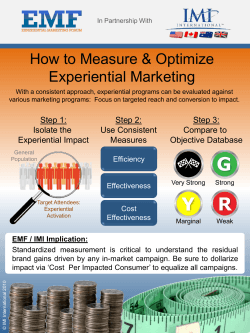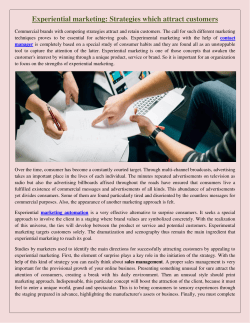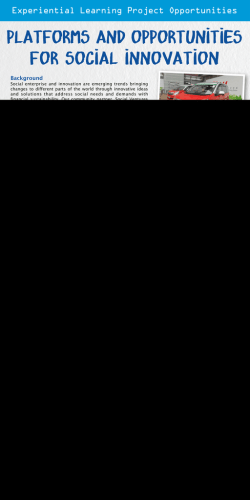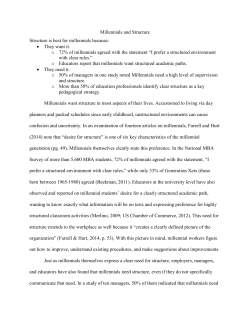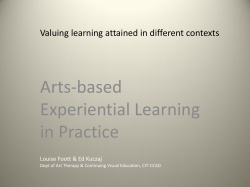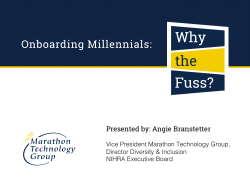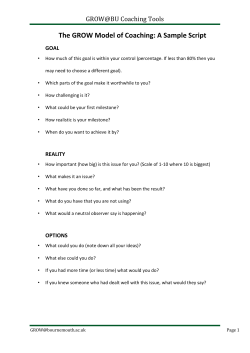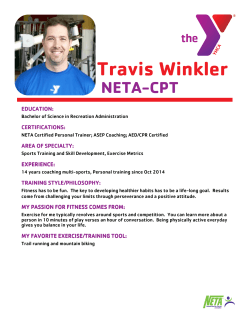
Accelerating Millennial Learning Through Multimodal Experiences
Accelerating Millennial Learning Through Multimodal Experiences Experiential training accelerates millennial learning because: It incorporates technology that appeals to millennials. o 87% percent of college students in America now own laptops. o 55% have smartphones. It provides opportunities for practice and development. o Learning from failure provides quick progress. o Millennials respond to training with a coaching orientation. Experiential learning incorporating technology accelerates skill acquisition. Experiential learning, as the phrase indicates, means learning through doing and reflecting on the experience (Kolb, 1984). While this educational model has been supported and used over the last few decades, millennials respond particularly well to it both because it has been used throughout their entire education and because it facilitates interaction and collaboration, which are characteristic traits of this generation (Hay, 2000; Howe & Strauss, 2000; Tapscott, 1998). However, experiential learning that incorporates technology is ideal for accelerated learning. There are two main reasons why. First, the proliferation of technology has reached the point of becoming pervasive, which means that experiential learning that incorporates technology reflects current trends. According to the Chronicle of Higher Education, 87% percent of college students in America now own laptops, and 55% have smartphones (Young, 2012). Pervasive computing represents the experiences of millennials, who expect technology to be incorporated into almost all aspects of the learning process (Basawapatna & Repenning, 2010; Vincelette, 2013). Using millennial preferences for technology results in more effective teaching because it engages students (Deal, Altman, & Rogelberg, 2010). Second, using information and communication technologies (ICT) has been found to accelerate learning (Park, 2014). The technological facility of today’s digital natives has been linked to faster language acquisition. In studies of exercises utilizing software and computers, students have been found to demonstrate accelerated learning of foreign languages (Liontas, 2002). ICT has influenced educational practices by increasing the presence of multimodal courses. These courses blend a variety of elements like simulations, video and audio materials, interactive programs, and traditional educational activities like discussion, reflection, and writing. The advantage of such an approach is that major concepts can be presented in a variety of modes to appeal to different learning styles (Gilakjani, 2011). Studies on multimodal courses have found that learners perceive it is easier to learn while attention rates and learning performance also increase (Sankey, 2006). Even beyond the blending of experiential learning with technology, the best multimodal strategies to accelerate learning incorporate practice and coaching. Unsurprisingly, research has indicated that multimedia courses are most successful when students have the opportunity to apply what they have learned after the instructional experience (Mayer, 2005). Other research has demonstrated that activities that involve students learning from failure work particularly well (Shepherd, 2004). Coaching and feedback enable practice and learning from failure to help students succeed. Students respond to clear, frequent feedback about their progress that also identifies and remedies misconceptions while reinforcing positive outcomes (Gee, 2005). Some research has shown that having a coaching orientation appeals especially to millennial students (Kutzhanova, Lyons, & Lichtenstein, 2009). M2M’s training program has incorporated this existing research in the design of a multimodal learning experience that results in accelerated skill acquisition. iPads play a pivotal role in this multimodal experience, requiring participants to give real-time feedback to each other, respond to coaching directions, and practice particular skills. Some research has found that iPads and tablet technology especially promote experiential learning (Robinson, 2012). Through the addition of peer coaching and multiple practice situations, students get constant feedback, learn from both failure and success, and acquire communication skills quickly. -By Amanda D. Taylor Bibliography Basawapatna, A. R., & Repenning, A. (2010). “Cyberspace meets brick and mortar: An investigation into how students engage in peer to peer feedback using both cyberlearning and physical infrastructures.” ITiCSE '10: 184-88. Deal, J., Altman, D., & Rogelberg, S. (2010). “Millennials at work: What we know and what we need to do (if anything).” Journal of Business & Psychology 25(2): 191-99. Gee, J. P. (2005). “Learning by design: Good video games as learning machines.” E-Learning (2): 5-16. Gilakjani, A. P. (2011). “Multimodal learning models and their impacts on English language teaching and learning.” ELT Voices 1 (4 and 5): 7-17. Hay, L. E. (2000). “Educating the Net Generation.” The Social Administrator 57 (54): 6-10. Howe, N. & Strauss, W. (2000). Millennials Rising. New York: Vintage Books. Kolb, D. A. (1984). Experiential learning: Experience as the source of learning and development. Englewood Cliffs, NJ: Prentice Hall. Kutzhanova, N., Lyons, T. S., & Lichtenstein, G. A. (2009). “Skill-Based development of entrepreneurs and the role of personal and peer group coaching in enterprise development.” Economic Development Quarterly 23(3): 193-210. Mayer, R. E. (2005). “Principles of multimedia learning based on social cues: personalization, voice, and image principles.” In The Cambridge Handbook of Multimedia Learning, ed. R. E. Mayer. New York: Cambridge University Press. Robinson, R. (2012). “Experiential learning in a new millennium: The implications of iPad technology in instructional settings.” In Proceedings of Society for Information Technology & Teacher Education International Conference 2012, 1242-48, ed. P. Resta. Chesapeake, VA: Association for the Advancement of Computing in Education. Sankey, M. D. (2006). “A neomillennial learning approach: Helping non-traditional learners studying at a distance.” The International Journal of Education and Development using Information and Communication Technology (IJEDICT) 2(4): 82-99. Shepherd, D. A. (2004). “Educating entrepreneurship students about emotion and learning from failure.” Academy of Management Learning and Education 3(3): 274-87. Tapscott, D. (1998). Growing up digital: The rise of the Net Generation. New York, NY: McGraw-Hill. Vincelette, E. J. (2013). “Video capture for grading: Multimodal feedback and the millennial student.” In Enhancing instruction with visual media: Utilizing video and lecture capture, 107-27, eds. E. G. Smyth and A. X. Volker. Hershey, PA: IGI Global. Young, Jeffrey R. (2012). “Campuses look to digital tools for savings, and reinvention.” Almanac of Higher Education 2012. The Chronicle of Higher Education.
© Copyright 2026
